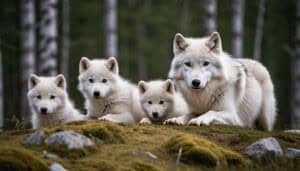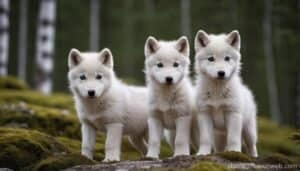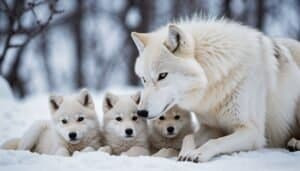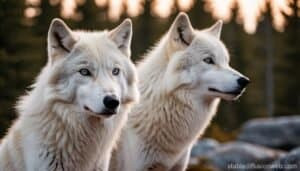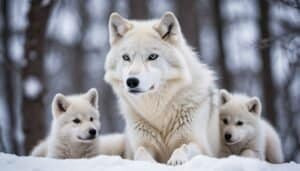Introduction
Arctic wolves are fascinating creatures adapted to one of the harshest environments on Earth. Understanding the dynamics of their reproduction, from litter size to pup survival, provides insight into their life cycle and the challenges they face
This article will explore the average litter size and birth process, parental care, and the various factors influencing the survival and development of Arctic wolf pups
Average Litter Size and Birth of Arctic Wolves
Arctic wolves, also known as white wolves, have adapted to survive in the frigid and harsh conditions of the Arctic. One of the fascinating aspects of their biology is their reproduction and litter size
Typical Number of Pups
Typically, an Arctic wolf gives birth to a litter of around four to six pups. This number can vary depending on several factors, such as the health of the mother, availability of prey, and environmental conditions
The average litter size is crucial for the population dynamics of the species, ensuring that enough pups survive to adulthood to maintain the population
Variation in Litter Size
While the average litter size is between four and six, there can be significant variation. Some litters may have as few as one or two pups, while others might have up to seven or eight
These variations are influenced by multiple factors, including the mother’s age and health, genetic factors, and the availability of resources. Larger litters are more common when food is abundant and the mother is in excellent health
Comparison with Other Wolf Species
Comparing Arctic wolves to other wolf species, such as the gray wolf, reveals interesting differences and similarities. Gray wolves typically have slightly larger litters, averaging five to six pups, but this number can also fluctuate based on environmental and genetic factors
The smaller litter size in Arctic wolves can be attributed to the harsher conditions they face, which makes raising a large number of pups more challenging
Breeding Season
Arctic wolves have a specific breeding season that usually occurs from March to May. The timing is crucial as it ensures that pups are born in the warmer months of the Arctic summer, giving them a better chance of survival
The gestation period for an Arctic wolf is approximately 63 days, after which the pups are born in a den that provides shelter and protection from the elements and predators
Birth Process
The birth process for Arctic wolves is a private and protected event. The mother, or alpha female, finds or digs a den in a secluded area to give birth
These dens are typically located in low-lying areas, often sheltered by rocks or vegetation. The pups are born blind and helpless, relying entirely on their mother for warmth and nourishment
Early Development Stages
In the early stages of life, Arctic wolf pups are entirely dependent on their mother. They begin to open their eyes after about ten days and start to explore their surroundings
By three weeks, they begin to venture outside the den under the watchful eye of their mother. At this stage, the pups start to develop their coordination and social skills through play and interaction with their littermates
The weaning process starts at around six to eight weeks, when the pups begin to eat regurgitated food provided by the mother and other pack members. This gradual introduction to solid food is crucial for their development and growth. By the time they are eight to ten weeks old, the pups are ready to start following the pack on short excursions, learning vital survival skills through observation and participation
Parental Care and Support in Arctic Wolves
Arctic wolves exhibit a remarkable social structure and strong familial bonds, which are crucial for the survival of their pups. Parental care extends beyond the mother to include the entire pack, ensuring the well-being and development of the young
Role of the Mother
The mother, or alpha female, plays a central role in the care and nurturing of the pups. From birth, she provides constant attention, warmth, and nourishment. For the first few weeks, the mother rarely leaves the den, focusing on feeding and protecting her vulnerable pups
She nurses them with her milk, which is rich in the nutrients needed for their rapid growth
As the pups grow, the mother begins to introduce them to solid food. She does this by regurgitating partially digested food, which the pups eagerly consume. This transition from milk to solid food is critical for their development, providing the necessary energy and nutrients for their increasing activity levels
Role of the Pack
In Arctic wolf packs, raising pups is a communal effort. The pack members, including the father and older siblings, all play a role in the care and protection of the young. This cooperative behavior ensures that the pups receive the attention and resources they need to thrive
The pack helps in several ways:
Provision of Food: While the mother stays with the pups, other pack members hunt and bring back food. They share their catch with the mother and, eventually, the pups, ensuring a steady food supply
Protection: The pack provides security against potential threats, such as predators and rival wolf packs. They guard the den area and are always on alert for danger, allowing the mother to focus on nurturing the pups
Teaching Survival Skills: Older pack members play a crucial role in teaching the pups essential survival skills. Through observation and interaction, the pups learn hunting techniques, social behaviors, and the dynamics of pack life. These lessons are vital for their development into capable and independent adults
Protection and Feeding
Protection and feeding are paramount in the early months of a pup’s life. The den provides a safe haven from the harsh Arctic environment and predators. The pack ensures that the den is kept secure and the pups are always under supervision
Feeding is a collaborative effort. Initially, the mother provides milk, but as the pups grow, they rely on regurgitated food from both the mother and other pack members. This shared responsibility helps distribute the energy demands among the pack, ensuring that the pups receive adequate nutrition
By the time the pups are a few months old, they begin to participate in hunts, albeit in a limited capacity. This gradual integration into the pack’s hunting activities is essential for their learning and development. They start by observing and then gradually take on more active roles as they grow stronger and more skilled
The combination of the mother’s dedicated care and the pack’s collective efforts ensures that Arctic wolf pups have the best possible chance of surviving and thriving in the challenging Arctic environment
Factors Influencing Litter Size and Survival
The litter size and survival rates of Arctic wolf pups are influenced by a variety of environmental and biological factors. Understanding these factors provides insight into the reproductive success and population dynamics of Arctic wolves
Environmental Conditions
The harsh and variable conditions of the Arctic environment play a significant role in determining litter size and pup survival. Harsh winters, scarcity of prey, and extreme cold can impact the health of the mother and the availability of resources necessary for raising pups:
Temperature: Extremely low temperatures can affect the survival of newborn pups, which are initially very vulnerable to the cold. Dens provide some insulation, but severe weather can still pose a threat
Weather Patterns: Unpredictable weather patterns, including storms and heavy snowfall, can impact hunting success and the ability to provide food for the pups
Habitat Quality: The availability of suitable den sites and the overall quality of the habitat influence the mother’s ability to protect and nourish her pups
Availability of Prey
The abundance and accessibility of prey are critical factors affecting litter size and pup survival. Arctic wolves primarily hunt large herbivores such as musk oxen and caribou, and the success of these hunts directly impacts the food supply for the pack:
Prey Population: Fluctuations in prey populations can lead to periods of abundance or scarcity. During times of abundance, mothers are more likely to have larger litters and higher pup survival rates
Hunting Success: The pack’s ability to successfully hunt and bring down prey affects the amount of food available for the mother and pups. Successful hunting requires cooperation and skill, which are honed through the pack’s social structure
Health of the Mother
The health and condition of the mother are crucial determinants of litter size and the pups’ initial survival. A healthy, well-nourished mother is more likely to have a successful pregnancy and provide adequate care for her pups:
Nutrition: Adequate nutrition before and during pregnancy ensures that the mother can sustain her health and provide for her pups. Poor nutrition can lead to smaller litters and lower survival rates
Age and Experience: Younger, inexperienced mothers may have smaller litters and higher pup mortality rates compared to older, more experienced mothers who are better equipped to care for their young
Survival Rates
Survival rates of Arctic wolf pups are influenced by a combination of genetic factors, environmental conditions, and the level of care provided by the mother and the pack:
Genetic Factors: Genetic diversity within the pack can influence the health and viability of the pups. Inbreeding can lead to genetic disorders and lower survival rates
Environmental Challenges: Pups must overcome various environmental challenges, including predators, disease, and harsh weather conditions. The protection provided by the pack helps mitigate these risks
Predators and Threats
Predators and threats in the Arctic ecosystem pose significant risks to wolf pups. Although Arctic wolves are apex predators, their pups are vulnerable to various threats:
Natural Predators: While adult wolves have few natural predators, pups can be threatened by other carnivores, such as bears and wolverines, which may prey on them if they stray too far from the den
Human Impact: Human activities, including hunting and habitat disruption, can indirectly affect wolf populations by reducing prey availability and increasing stress on wolf packs
Impact of Climate Change
Climate change poses a growing threat to Arctic wolf populations by altering their habitat and the availability of prey. Rising temperatures, changing weather patterns, and melting ice can have profound effects on the ecosystem:
Habitat Loss: As the Arctic ice melts, the habitat available to Arctic wolves and their prey diminishes, leading to increased competition for resources
Prey Availability: Changes in the migration patterns and populations of prey species due to climate change can result in food shortages for wolf packs
Conclusion
Arctic wolves, resilient and adapted to one of the planet’s most extreme environments, face numerous challenges in their life cycle, particularly during the early stages of pup development
The average litter size of Arctic wolves typically ranges from four to six pups, although this can vary based on environmental conditions, the mother’s health, and the availability of prey. The birth and early development of the pups are crucial periods, with the mother and pack members playing significant roles in providing care, protection, and food
Parental care in Arctic wolves is a communal effort, with the mother nursing and nurturing the pups while the pack assists in hunting and guarding the den. This cooperative behavior ensures the pups receive the necessary resources and learn vital survival skills
Various factors influence litter size and survival rates, including environmental conditions, prey availability, the health of the mother, and genetic diversity. Harsh weather, scarcity of prey, and threats from predators and human activities further impact the survival of the young wolves
The effects of climate change pose additional challenges by altering the Arctic habitat and affecting the availability of prey, which can lead to food shortages and increased competition
Despite these obstacles, Arctic wolves exhibit remarkable adaptability and social structures that enhance the survival and development of their pups. Understanding these dynamics is essential for conserving and managing Arctic wolf populations, ensuring these majestic creatures continue to thrive in their natural habitat



